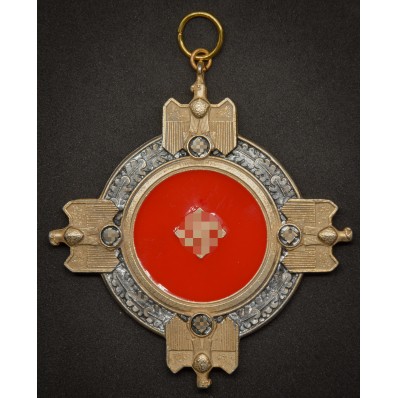Keine Artikel
Artikel wurde in den Korb gelegt
Sie haben 0 Artikel in Ihrem Warenkorb. Es gibt 1 Artikel in Ihrem Warenkorb.
Deutscher Nationalorden für Kunst und Wissenschaft, Vorlagemuster II
Neu
Vorlagemuster II des Deutschen Nationalordens für Kunst und Wissenschaft, gestiftet am 30. Januar 1937. Vergoldetes Silber mit roten Emailleflächen, Eichblattkranz, zentrale bewegliche Vergoldete Swastika, nationale Adler an den Himmelsrichtungen mit mobilen Swastiken, Rückseite mit der Aufschrift „FÜR KUNST UND WISSENSCHAFT“. Maße ca. 83.50×89.50 mm; Gewicht 68.80 gr.
Produkt vorübergehend nicht auf Lager.
- Zufrieden oder erstattet: Wir garantieren 100% sicheren Schutz für Ihre Einkäufe
- Kostenlose Rücksendung: Senden Sie Ihre Bestellung innerhalb von 30 Tagen kostenlos zurück
- Sichere Zahlungen: Bezahlen Sie sicher online mit PayPal oder Kreditkarten

Mehr Infos
Der Deutsche Nationalorden für Kunst und Wissenschaft wurde am 30. Januar 1937 von Adolf Hitler eingeführt, nachdem deutsche Staatsbürger per Direktive untersagt worden war, Nobelpreise anzunehmen – als Reaktion auf die Verleihung des Friedensnobelpreises 1935 an Carl von Ossietzky, der unter anderem die geheime Aufrüstung der Wehrmacht und den zunehmenden Antisemitismus kritisierte. Der Orden sollte eine innerdeutsche Alternative bieten, eine staatliche Ehrung für herausragende Leistungen in Kunst, Wissenschaft und Kultur nach NS-Vorstellungen.
Das hier vorgestellte Stück ist ein Vorlagemuster II, ein äußerst seltener Prototyp. Seine Vorderseite zeigt einen Kranz aus Eichblättern, umrahmt von vergoldeten Ringen, einen roten Emaille-Diskus mit beweglicher vergoldeter Swastika. An den vier Himmelsrichtungen sind nationale Adler im NSDAP-Stil angebracht, jeder hält eine mobile Swastika. Auf der Rückseite befindet sich ein analoger roter Scheibe mit erhabener vergoldeter Inschrift „FÜR KUNST UND WISSENSCHAFT“. Vier sichtbare Nieten sichern die Adler auf der Vorderseite, die Öse der zwölf-Uhr-Adler dient zur Befestigung über Doppelnackenringen.
Historisch gesehen wurden nur neun dieser Auszeichnungen in den Jahren 1937 und 1938 verliehen, bevor das Projekt mit Beginn des Zweiten Weltkriegs eingestellt wurde. Prototypen wie dieser zeigen die Entwicklungsphasen des Ordensdesigns, die ideologischen Vorgaben des Regimes und den Anspruch an Handwerk und Material. Für Sammler und Historiker sind solche Vorlagemuster von außerordentlichem Wert: jedes Detail – Adlerstil, Emaillefarbe, Niet-Befestigung – kann auf die verwendete Werkstatt, die frühe Designphase und darauf hinweisen, ob dieser Prototyp je für eine öffentliche Verleihung oder nur als Modell gedacht war.
Technische Daten
| Breite | 83.50 mm |
| Länge | 89.50 mm |
| Dicke | 6.50 mm |
| Gewicht | 68.80 gr |
| Material | Zamak, Messing, Emaille |
Medaillen mit Bändern
- Deutschland
- Medaillen, Orden und Steckorden
- Kriegsabzeichen
- Erkennungsmarken
- Armschilde
- Schirmmützen und Hüte
- Mützenabzeichen, Helmabzeichen
- Auflagen für Kragenspiegel und Schulterklappen
- Kragenspiegel, Schulterklappen und Epauletten
- Armbänder
- Armelbander
- Koppelschlösser, Gürtel und Koppelriemen
- Knöpfe für Uniformen
- Stempel
- Ringkragen
- Ringe
- SS-Ehrenring aus 925er Silber - Sammlerset
- Fahnenspitzen
- Fahnen
- Dolche und Messer (Zierpflanzen)
- Feldmarschall Taktstöcke
- Munitionstaschen, Patronengürtel und -taschen
- Dienstuhren
- Präsentationsfälle
- Dokumente und Auszeichnungsschreiben
- Büsten, Adler, Feuerzeuge und Sonstiges
- Kroatische und Ustascha Militaria
- Entnazifizierte Artikel
- Gedenkhalsketten
- Ersatzteile, Kleinteile und Accessoires
- Italien
- Medallien und Orden
- Kriegsabzeichen
- Schilde und Blutplättchen
- Ringkragen
- Schirmmützen und Hüte
- Mützenabzeichen, Helmabzeichen
- Friese für Kragenspiegel
- Kragenspiegel, Schulterklappen und Epauletten
- Koppelschlösser und Schnallen
- Koppelriemen
- Knöpfe für Uniformen
- Ringe
- Fahnenspitzen
- Italienischer Widerstand
- Schlüsselringen
- Wappenschilde
- Dolche
- Fahnen
- Büsten und Adler
- Gadgets und Geschenke
- Gedenkhalsketten
- Deutsches Kaiserreich
- Sowjetunion
- Andere Länder








